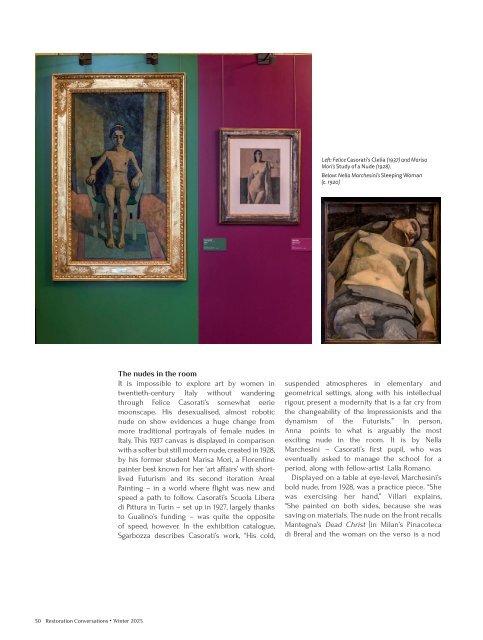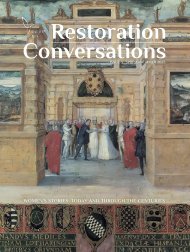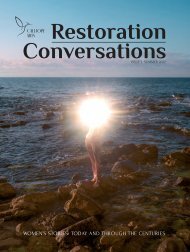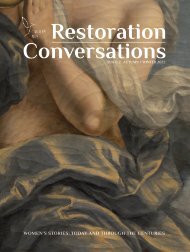Winter 2023
Restoration Conversations is a digital magazine spotlighting the achievements of women in history and today. We produce two issues a year: Spring/Summer and Fall/Winter
Restoration Conversations is a digital magazine spotlighting the achievements of women in history and today. We produce two issues a year: Spring/Summer and Fall/Winter
Create successful ePaper yourself
Turn your PDF publications into a flip-book with our unique Google optimized e-Paper software.
Left: Felice Casorati’s Clelia (1937) and Marisa<br />
Mori’s Study of a Nude (1928).<br />
Below: Nella Marchesini’s Sleeping Woman<br />
(c. 1920)<br />
The nudes in the room<br />
It is impossible to explore art by women in<br />
twentieth-century Italy without wandering<br />
through Felice Casorati’s somewhat eerie<br />
moonscape. His desexualised, almost robotic<br />
nude on show evidences a huge change from<br />
more traditional portrayals of female nudes in<br />
Italy. This 1937 canvas is displayed in comparison<br />
with a softer but still modern nude, created in 1928,<br />
by his former student Marisa Mori, a Florentine<br />
painter best known for her ‘art affairs’ with shortlived<br />
Futurism and its second iteration Areal<br />
Painting – in a world where flight was new and<br />
speed a path to follow. Casorati’s Scuola Libera<br />
di Pittura in Turin – set up in 1927, largely thanks<br />
to Gualino’s funding – was quite the opposite<br />
of speed, however. In the exhibition catalogue,<br />
Sgarbozza describes Casorati’s work, “His cold,<br />
suspended atmospheres in elementary and<br />
geometrical settings, along with his intellectual<br />
rigour, present a modernity that is a far cry from<br />
the changeability of the Impressionists and the<br />
dynamism of the Futurists.” In person,<br />
Anna points to what is arguably the most<br />
exciting nude in the room. It is by Nella<br />
Marchesini – Casorati’s first pupil, who was<br />
eventually asked to manage the school for a<br />
period, along with fellow-artist Lalla Romano.<br />
Displayed on a table at eye-level, Marchesini’s<br />
bold nude, from 1928, was a practice piece. “She<br />
was exercising her hand,” Villari explains,<br />
“She painted on both sides, because she was<br />
saving on materials. The nude on the front recalls<br />
Mantegna’s Dead Christ [in Milan’s Pinacoteca<br />
di Brera] and the woman on the verso is a nod<br />
30 Restoration Conversations • <strong>Winter</strong> <strong>2023</strong>





